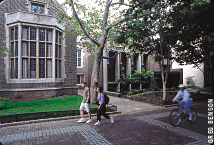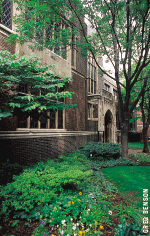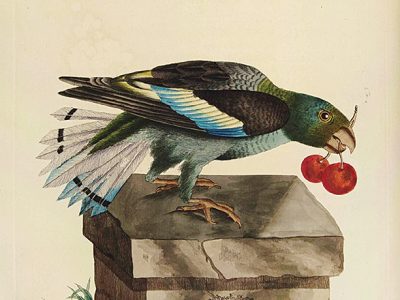
After more than two months of debate and deliberation, the Locust Walk Advisory Committee —whose 12 members were drawn from the ranks of faculty, students and administrators—released a set of recommendations in April for a key section of real estate along the Walk. Those recommendations, which were promptly approved by Penn President Judith Rodin, could have a significant impact on the level of activity in the heart of campus —specifically, the four buildings lining the north side of Locust Walk just west of 36th Street.
“Having a number of spaces come available all at once, we suddenly realized we had the chance to change the dynamic of part of Locust Walk,” noted Dr. Robert Barchi Gr’72 M’72 GM’73, the provost, who chaired the committee. By next fall the Walk “will be alive day and night with student energy and activity,” he predicted. Add the soon-to-be-completed Perelman Quadrangle back into the mix, and the center of campus “will be more vibrant than it has ever been.”
The recommendations call for a new cultural and performing-arts center, space for several ethnic and minority organizations, an “undergraduate research hub,” a center for graduate students, a shared space for student religious groups, and several centers in the School of Arts and Sciences, including the Humanities Forum and the McNeil Center for Early American Studies. The committee also tentatively recommended that a sorority move into the 3609-11 building, which now houses the office of the vice provost for University life. That plan is somewhat indefinite now, partly because of the high cost of converting the building into a quality residential space.
While the recommendations inspired mostly positive comments in The Daily Pennsylvanian, there were some dissenters, particularly in the Greek community.
“The Locust Walk recommendations are a very touchy subject for many members of the University community,” said Andrew Mandelbaum C’01, president of the Interfraternity Council (IFC). He added that he was “disappointed that there were no representatives of the Greek community invited to serve on the allocations committee, especially since many of the buildings the committee was allocating were former fraternity houses.” (Actually, one member of the committee, Michael Silver C’01, is a member of Phi Kappa Psi, but since he is also chair of the Undergraduate Assembly, he was obligated to “represent all undergraduates,” Mandelbaum noted. Silver described the recommendations to the DP as a “crazy-good mix of allocations.”)

Dr. Peter Conn, the Andrea Mitchell Professor of English and deputy provost who served on the committee, said that while various campus groups were competing for space along the Walk, the committee made a serious effort to “gather all the relevant information, bringing into the conversation representatives of students and faculty.” He added that a “careful assessment of the spaces” was made to address the most effective uses to which each might be put, noting that all the organizations that ended up getting space along the Walk had legitimate and longstanding requests.
While two of the buildings had, until recently, housed fraternities, the linchpin of the planned changes is the former Christian Association building at the corner of 36th Street and Locust Walk, which the University purchased last year.
“The CA building lies at the symbolic and indeed literal center of campus,” noted Conn. “We have tried to find homes for a rich mix of activities, thus enhancing the diversity of this central campus walkway. You will notice that the programs we’ve identified for inclusion reach from a cluster of SAS initiatives to a Center for Undergraduate Research and Fellowships to a gathering of student organizations. Each of these programs, taken individually, lends value to the Walk, but the biggest gains have been achieved by the collectivity and variety.”
The former CA building currently houses, among other things, the Palladium restaurant and the Gold Standard cafeteria, whose leases expire at the end of 2002. In the short run, the handsome neo-Gothic building will house La Casa Latina, the Pan Asian American Community House, UMOJA, a satellite office for the Greenfield Intercultural Center, swing office space for performing-arts groups, and the Center for Undergraduate Research and Fellowships. Although the Palladium and Gold Standard are scheduled to leave when their leases expire, some sort of dining venue will probably occupy the Palladium’s space. Performing-arts offices will be housed in the rest of the ground floor, and the basement level (now home to the Gold Standard) will be dominated by performing-arts groups.

Nine years ago, the Committee to Diversify Locust Walk recommended that the fraternities along the walkway could stay—if their members behaved—and that most of the section east of 38th Street could remain essentially the same. Since then, a number of fraternities have departed, including Phi Sigma Kappa at 3615 Locust Walk (now known as the Veranda) and Phi Gamma Delta (FIJI) at 3619 Locust Walk. Phi Sigma Kappa’s charter was suspended and its chapter closed by its national office in 1998, following “numerous behavioral issues, risk-management violations and financial issues,” according to the provost’s office; the chapter will be allowed to recolonize this year in time for its 100th anniversary, but not at its old site. The Veranda will house the new Graduate Student Center—addressing a longstanding grievance by Penn’s 10,000 graduate and professional students that they had no central site for socializing, studying and otherwise interacting—and its ground floor will provide shared space for student religious groups.
FIJI’s charter was voluntarily surrendered last year by its undergraduate members when alumnus Michael Tobin C’94 died in an alcohol-related incident. Although no permanent decision has been made about the long-range use of the building, it will house the various SAS centers until at least 2003. At that time, the Beta chapter of FIJI could begin to recolonize and the University could potentially consider the chapter’s re-recognition.
“While I understand the push towards diversity,” said the IFC’s Mandelbaum, “I also hope the University understands the importance of the presence of fraternities on Locust Walk.” He called the proposal to include a sorority a “promising” idea, adding: “I hope that happens shortly.”

“Fraternities and sororities provide students with an important social and cultural option and one that can help instill a feeling of real community,” said Barchi. “I aim to work closely with Greek leaders to support them as they make the necessary changes in order to continue to thrive in the 21st century. My own experience with Greek leaders on campus has been overwhelmingly positive, and many of them helped craft the new alcohol policy that was put in place this last year.
“The Locust Walk committee had as its clear mandate the establishment of a vibrant, diverse Walk that would come alive both day and night,” he added. “Greeks are an important part of the diversity along the Walk. We have committed space in the future for a sorority, demonstrating our commitment to Greek life on the Walk, and to maintaining a residential presence as well.”
In an editorial titled “The future of Locust Walk,” The Daily Pennsylvanian said that the committee’s efforts “will make Locust Walk a more diverse and vibrant place to work, play and pray. But as space opens up elsewhere on campus, we hope that administrators make room for a greater residential presence on Locust Walk.”




